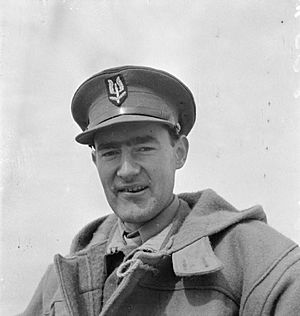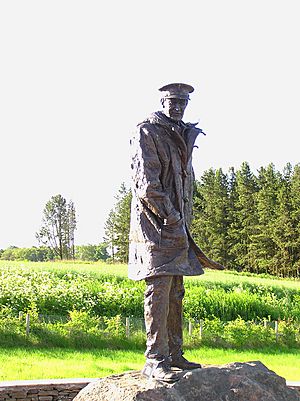David Stirling facts for kids
Quick facts for kids
Sir David Stirling
|
|
|---|---|

David Stirling in 1942
|
|
| Birth name | Archibald David Stirling |
| Nickname(s) | "The Phantom Major" |
| Born | 15 November 1915 Bridge of Allan, Scotland |
| Died | 4 November 1990 (aged 74) Westminster, London, England |
| Allegiance | United Kingdom |
| Service/ |
British Army |
| Years of service | 1937–1965 |
| Rank | Lieutenant colonel |
| Service number | 72647 |
| Unit | Scots Guards No. 8 (Guards) Commando |
| Commands held | Special Air Service |
| Battles/wars | |
| Awards | Knight Bachelor Distinguished Service Order Officer of the Order of the British Empire Mentioned in Despatches |
| Alma mater | Trinity College, Cambridge |
| Relations | Archibald Stirling (father) |

Sir Archibald David Stirling (born 15 November 1915 – died 4 November 1990) was a brave British Army officer and a skilled mountaineer. He is most famous for creating the Special Air Service (SAS), a very special group of soldiers. He fought in the Second World War.
Contents
Early Life
David Stirling was born on 15 November 1915, at his family home in Scotland. His father was Brigadier-General Archibald Stirling. David went to a Catholic boarding school called Ampleforth College. He then spent a year at Trinity College, Cambridge before moving to Paris to become an artist.
Stirling was very tall, about 6 feet 6 inches (1.98 meters), and athletic. Before the Second World War started, he was even training to climb Mount Everest.
Second World War and the Founding of the SAS
In 1937, Stirling joined the Scots Guards, a part of the British Army. When the war began, he volunteered for a new commando unit. This unit, called "Layforce," faced many challenges and was eventually disbanded.
Stirling believed that small, highly trained teams of soldiers could attack enemy targets quickly and by surprise. He thought this would be very effective in the desert.
A Bold Idea
Stirling decided to share his idea with the top general, Claude Auchinleck. Even though he was on crutches from a parachuting accident, he snuck into the army headquarters in Cairo. He managed to explain his plan to a senior officer, who then convinced General Auchinleck. Stirling was given permission to form his new special unit. To keep it a secret, they gave it a misleading name: "L Detachment, Special Air Service Brigade."
Early Missions
At first, Stirling's new unit, the SAS, didn't have much equipment. So, they "borrowed" supplies like tents and furniture from a nearby New Zealand regiment!
Their first mission was tough. They tried to parachute into a German airfield in November 1941, but a huge storm blew them off course. Many soldiers were lost. After this, Stirling realized that traveling by land at night would be much safer and more effective. He quickly started organizing raids using this new method.
Desert Raids
Stirling and his team became very good at sneaking past enemy checkpoints at night. They used special American Jeeps that could handle the desert. These Jeeps were fitted with machine guns, making them powerful attack vehicles. Stirling also came up with the idea of using small groups of soldiers to avoid being seen.
He often led his SAS units himself, driving Jeeps right through enemy airfields to destroy aircraft and attack enemy crews. One of his biggest successes was in July 1942. His SAS squadron, using 18 Jeeps, attacked the Sidi Haneish airfield and destroyed 37 enemy aircraft. This was a huge blow to the enemy!
Because of his success, Stirling was promoted to Lieutenant Colonel in September 1942. The Germans called him "The Phantom Major" because he was so hard to catch.
Capture and Colditz
However, Stirling's daring raids eventually led to his capture by the Germans in January 1943. He managed to escape, but was soon recaptured by the Italians. He tried to escape four more times! In the end, he was sent to Colditz Castle, a famous prison for high-value prisoners, where he stayed until the end of the war.
Before Stirling's capture, the SAS had destroyed over 250 enemy aircraft, many supply depots, and hundreds of vehicles in North Africa. Field Marshal Bernard Montgomery even called Stirling "mad, quite mad" because of his bold ideas! After Stirling's capture, Paddy Mayne took over command of the SAS.
Later Life
After the war, Stirling was worried about Britain's future. He started companies like Watchguard International Ltd. These companies helped other countries with security and military training. They mostly worked with countries in the Middle East.
Stirling also founded the Capricorn Africa Society in 1949. This group worked to promote equality and fight against racial discrimination in Africa, which was still under colonial rule at the time. He wanted to create a society where people of all races could live together fairly.
Honours
David Stirling received many awards for his bravery and service.
- In 1942, he was given the Distinguished Service Order for his excellent service in the Middle East.
- In 1946, he was made an Officer of the Order of the British Empire.
- In 1990, he was made a Knight Bachelor for his contributions to the military. This means he was given the title "Sir."
In 1984, the main base of the SAS was renamed Stirling Lines in his honour. In 2002, a statue of David Stirling was unveiled near his family's home in Scotland. It shows him standing on a rock, honoring his legacy.
See also
 In Spanish: David Stirling para niños
In Spanish: David Stirling para niños
- List of French paratrooper units

